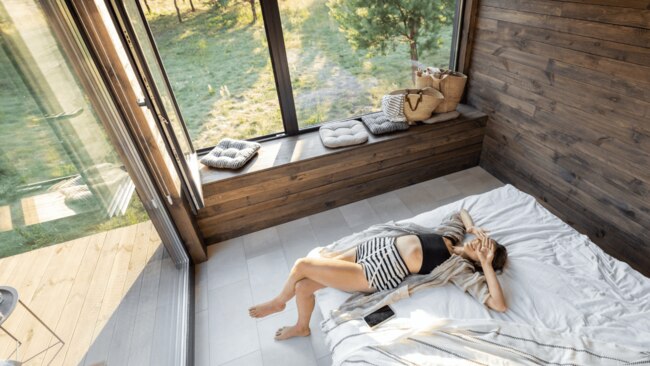Forget bed-rotting, 2024 is all about Non-Sleep Deep Rest
All you need is a safe spot to lay down
Lifestyle
Don't miss out on the headlines from Lifestyle. Followed categories will be added to My News.
Experts say the practice of deep relaxation can improve everything from anxiety symptoms to your ability to learn new things.
“Say YES to REST!” implored the text in a tiny square on my phone, pulling my thumb into a mid-scroll hover.
“You’re invited to a three-day rest camp for exhausted women,” the advertisement continued, “do you dare to commit?”
The course, run by women’s wellbeing coach and author, Karen Brody, was actually an online seminar on the practice of Yoga Nidra, a technique rooted in ancient methods for calming the mind and body.
Like what you see? Sign up to our bodyandsoul.com.au newsletter for more stories like this.
Post-Christmas and right in the middle of the work and school holiday juggle, the depth of my tiredness was such that while a three-day ‘rest camp’ sounded like exactly the kind of relief I could dive into, I was … too exhausted to bother signing up. The irony of this barely registered as I continued scrolling onto the greener and more immediately gratifying pastures of impulse-buying a new water bottle to solve all my problems (real ones know Owala is the new Frank Green).
As 2024 gathered steam, however, so too did the conversation about rest.
Do less, better
The benefits of sleep have been well-researched and communicated for years now. From Ariana Huffington’s bestselling The Sleep Revolution - born of her come-to-Jesus moment about the dangers of long-term sleep deprivation, to more politicised conversations about rest led by the important work of Tricia Hersey and her book, Rest Is Resistance, we’ve been well-versed in the power of shut-eye for at least a decade.
Last year, we were all about ‘bed-rotting’, and while 12 hours spent bingeing season four of Succession is never a day wasted, the dawn of a new year has brought about a more nuanced, scientific approach to restorative rest.

While Yoga Nidra (Sanskrit for ‘yogic sleep’) has been around in one form or another for millennia, it is a tool that falls under the umbrella of ‘Non-Sleep Deep Rest’ (NSDR) - a term coined by neuroscientist and cult podcaster Dr Andrew Huberman, describing the practice of deep relaxation that can improve everything from anxiety symptoms to your dopamine threshold and ability to learn.
To do an NSDR meditation, all you need is a guided YouTube video or soundtrack, and a safe place to lie down. Simple.
Rest is trending
Like perineum-sunning and vaginal steaming before it, NSDR - along with the ever-growing additions to the hashtag on TikTok - at first has the whiff of a wellness fad to it. ‘Neuro-tok’ is littered with neuroscience aficionados offering video rundowns and guided meditations of their own.
But unlike other wellness trends, the evidence here stacks up - impressively so.
Carly Dober, principal psychologist at Enriching Lives in Melbourne, has been incorporating NSDR into the toolkit of techniques she offers clients for some time - although she notes she’s seen a big uptick in awareness and demand recently.
“I think the reason we’re seeing more people interested in this kind of restorative rest is that people are understanding and experiencing burnout more,” Dober muses.
“We all understand that yes, rest is important, but when you’re exposed to overstimulation on a daily basis like we are in modern life, people want something more nourishing and sustainable.”
“NSDR asks us to focus on two things at once,” Dober explains, “being in a deep state of relaxation (which can be very difficult to do), plus enhancing our perception and how much we are concentrating on one particular theme.”
“I encourage clients - especially those who might be juggling a number of responsibilities at once - to try NSDR. The ones who are able to incorporate it have reported it’s incredibly helpful, and particularly for some male clients, it’s a way into mindfulness-like practices that doesn’t feel so female-coded.”

The brain-changing magic of NSDR
It’s difficult to find a wellness trend with a better ROI than NSDR, at least in recent history.
“The thing I love most about NSDR is that it’s completely free,” Dober continues, “in the context of the cost-of-living crisis we’re currently in, perhaps people don’t have the capacity to pay for meditation or breathwork classes they might once have attended. This is an incredibly powerful tool and it is accessible to everyone with a phone.”
Clinical studies have shown meditation to be associated with improvements in red blood cell counts, blood glucose levels and hormonal status, for a start. The benefits can even be seen in neuroimaging, and studies have shown yoga nidra “produces changes in endogenous dopamine release and cerebral blood flow.”
Most compelling of all, however, could be this 2022 study showing that 60 minutes of NSDR can deliver the equivalent benefits of four hours of restorative sleep.
I’ll repeat that for all my sleep-deprived parents in the trenches: there might just be a way to bank a precious few extra sleep hours worth of health benefits when REM sleep has eluded you.
That’s something even my fancy new water bottle can’t offer.
More Coverage
Originally published as Forget bed-rotting, 2024 is all about Non-Sleep Deep Rest




